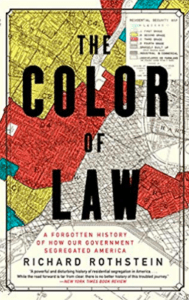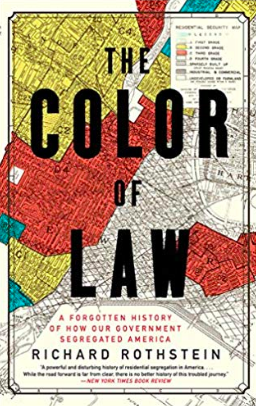“An unjust law is no law at all.” —St. Augustine
This quote from St. Augustine says it all for me after reading Richard Rothstein’s well-researched book The Color of Law (AMAZON). As an educator who spent the last 10 plus years working for the courts, where the rule of law reigns supreme, this book challenged what I thought I knew about segregation, racism, public housing and the law. As such, this enlightening book is valuable to judges and court employees for understanding who comes to court and how they get there.
 Richard Rothstein’s thesis is that local, state, and federal laws, rules and policies deliberately caused segregation in public housing, beginning primarily around World War II when severe housing shortages for war workers caused the government to build public housing in large numbers where war industries existed. While the common supposition is that housing segregation is de facto (people live in segregated neighborhoods out of personal choice), Mr. Rothstein argues that segregation in housing is in fact de jure (a result of laws and policies of the government). His arguments are compelling and are a lesson for everyone in the court system, in fact for all citizens, about why housing segregation really happened, and what might be done about it.
Richard Rothstein’s thesis is that local, state, and federal laws, rules and policies deliberately caused segregation in public housing, beginning primarily around World War II when severe housing shortages for war workers caused the government to build public housing in large numbers where war industries existed. While the common supposition is that housing segregation is de facto (people live in segregated neighborhoods out of personal choice), Mr. Rothstein argues that segregation in housing is in fact de jure (a result of laws and policies of the government). His arguments are compelling and are a lesson for everyone in the court system, in fact for all citizens, about why housing segregation really happened, and what might be done about it.
While currently most public housing is targeted towards the poor, in its early days, public housing was built for working- and middle-class families. Since few houses were constructed during the Depression, a huge shortage of housing developed in the 1930’s. When the economy ramped up with as WWII began, millions of workers, both white and African-American, migrated to cities where those factories offered work. The government invested in public housing to provide war workers with homes. But rather than make this housing available to all workers in all areas, the laws passed by Congress and the policies of the Public Works Administration, and later the Federal Housing Authority, required subdivisions to be segregated. The 1949 Federal Housing Act, which Mr. Rothstein calls the “poison pill” of housing legislation, affirmed segregation practices in law. In addition, many more white subdivisions were built than African-American subdivisions, forcing black people into crowded conditions or dwellings far from their work sites as they tried to find adequate housing. In addition, black subdivisions tended to be built in less desirable locations, for example, near heavy industry and dumps, where polluted conditions compromised the health of those forced to live there. No other choices were available to them.
In addition, African-American workers were hired only for the most menial and lowest-paying positions, until the dire need for workers forced war industries to hire them for any position for which they had the aptitude. But the greater pay these workers earned did not allow them access into white subdivisions even when they could afford to live there.
According to Mr. Rothstein, and supported in public record, the results of forcing segregation where it had previously not existed or was minimal, like in California, were many, and continue to exist and harm African-Americans today. In addition to negative health conditions mentioned above, another result of forced segregation was overcrowded neighborhoods which turned into slums. With housing for African-Americans in short supply, families subdivided their homes and took in renters, multiple families shared homes, and the resulting overcrowding caused neighborhoods to go downhill. In addition, housing segregation reinforced school segregation, and black schools were underfunded and inferior to white schools. Since black families could not buy houses that they could afford in better neighborhoods, they were not able to accumulate wealth and education the way white families could, a disparity that continues today. Mr. Rothstein explains clearly how government-sanctioned housing segregation negatively impacted, and continues to negatively impact, black families in areas of health, achievement gaps, wealth disparities, and mass incarceration.
As an example of how housing segregation continues to hurt African-American families, Mr. Rothstein shows how in the time prior to the great recession of 2008-2009, lenders targeted low-income people and African-Americans (both working- and middle-class) for toxic mortgages in far greater numbers than middle class white Americans. When the recession occurred, these families lost most of the wealth they had earned over decades. African-Americans who lost their wealth with their homes far exceeded white Americans in the same situation.
Mr. Rothstein finishes his book with possible remedies to the continued discrimination against African-American families. His solutions are sometimes radical, a fact he admits. As one example, he cites the gentrification of older neighborhoods around city centers. Mr. Rothstein states that while gentrification is not necessarily a bad thing, unless something is done to help the poorer neighbors living in these neighborhoods so that they can either upgrade their homes and stay or purchase reasonable housing elsewhere, gentrified neighborhoods end up richer, whiter enclaves and poorer residents end up in slums since those areas are often all they can afford when rents become unaffordable where they used to live.
The Color of Law is rich with well-documented history and details of how public housing became segregated, how it hurt African-Americans, and how it continues to harm them. The fact that this segregation was de jure and not de facto provides a rich area to begin a discussion with judges and other court employees. This book is recommended for all court employees and is an excellent choice for any law and literature class or book club discussion.
 Formerly the Pima County (Arizona) Field Trainer and a Superior Court Training Coordinator, Nancy Smith has over 10 years of experience working in court training and education, first at the Washington State AOC and at Pima County Superior Court (Tucson, AZ). She currently is a partner at Sustainable Change Coaching and Consulting. She came to the courts with 16 years of experience in education, both as a community college instructor and a high school teacher in Tucson, and as a curriculum coordinator at the Evergreen State College in Olympia, WA. Nancy taught many kinds of court related classes, including topics such as implicit bias and faculty development, and court related topics like due process and procedural fairness. She has a special interest in adult learning theory and application. Nancy has branched out into a new business, where she and her partner plan to teach court leaders coaching skills to improve employee performance and retention. She speaks periodically at conferences on topics related to judicial education and publishes articles for the National Association of State Judicial Educators (NASJE). Currently, she serves on the NASJE Board as the Western Region Director as well as on the Communication and Conference Committees. She earned her bachelor’s degree in French and History at the College of William and Mary in Virginia, and her Master’s in French from the Free University of Brussels, Belgium. Nancy grew up in a Navy family, married into an Army family and served four years as an Army Intelligence officer. She has traveled widely around the United States and Europe as well as to Peru, Mexico and China. She likes the outdoors, and swims, hikes, bikes and does yoga for fun and fitness. She can be reached at .
Formerly the Pima County (Arizona) Field Trainer and a Superior Court Training Coordinator, Nancy Smith has over 10 years of experience working in court training and education, first at the Washington State AOC and at Pima County Superior Court (Tucson, AZ). She currently is a partner at Sustainable Change Coaching and Consulting. She came to the courts with 16 years of experience in education, both as a community college instructor and a high school teacher in Tucson, and as a curriculum coordinator at the Evergreen State College in Olympia, WA. Nancy taught many kinds of court related classes, including topics such as implicit bias and faculty development, and court related topics like due process and procedural fairness. She has a special interest in adult learning theory and application. Nancy has branched out into a new business, where she and her partner plan to teach court leaders coaching skills to improve employee performance and retention. She speaks periodically at conferences on topics related to judicial education and publishes articles for the National Association of State Judicial Educators (NASJE). Currently, she serves on the NASJE Board as the Western Region Director as well as on the Communication and Conference Committees. She earned her bachelor’s degree in French and History at the College of William and Mary in Virginia, and her Master’s in French from the Free University of Brussels, Belgium. Nancy grew up in a Navy family, married into an Army family and served four years as an Army Intelligence officer. She has traveled widely around the United States and Europe as well as to Peru, Mexico and China. She likes the outdoors, and swims, hikes, bikes and does yoga for fun and fitness. She can be reached at .

